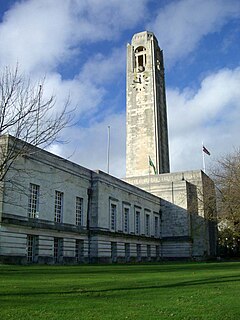Swansea Guildhall
| Guildhall | |
|---|---|
Guildhall Abertawe | |
 Swansea guildhall c.2006 | |
 | |
| General information | |
| Location | Swansea, Wales |
| Address | Swansea SA1 4PE |
| Coordinates | 51°36′51.00″N 3°57′37.00″W / 51.6141667°N 3.9602778°W |
| Construction started | 1932 |
| Completed | 1934 |
| Inaugurated | 23 October 1934 |
| Cost | £300,000 |
| Owner | City and County of Swansea Council |
| Height | 48 metres (clock tower) |
| Design and construction | |
| Architect | Sir Percy Thomas |
| Main contractor | Messrs. E Turner & Sons Ltd |
| References | |
Listed Building – Grade I | |
| Official name | Swansea Guildhall |
| Designated | 25 July 1994 |
| Reference no. | 14594 |
The Guildhall (Welsh: Guildhall Abertawe) is one of the main office buildings of the City and County of Swansea Council. The Guildhall complex, which includes the City Hall, Brangwyn Hall (concert hall) and the County Law Courts for Swansea, is a Grade I listed building.[1]
History[]

The building was commissioned to replace the old Swansea Guildhall.[2] The site selected for the building had previously formed part of Victoria Park. The foundation stone for the building was laid on 4 May 1932.[1] The building was designed by Sir Percy Thomas in the neoclassical style and was officially opened by The Duke of Kent on 23 October 1934.[3][4][5]
The design envisaged a building finished in white Portland stone, and included a 48 metres (157 ft) art deco clock-tower, making it a landmark.[6] The clock-tower featured the prow of a Viking longship, jutting out on each side as a reminder of Sweyn Forkbeard, thought to be the founder of Swansea.[7] The council chamber used panelling made of Australian walnut and columns 22 feet (6.7 m) high.[8] Bronze busts depicting the local Members of Parliament, David Matthews, David Williams, Percy Morris and David Grenfell, were subsequently installed outside the council chamber.[8] Percy Thomas won the Bronze Medal for Architecture from the Royal Institute of British Architects for his work in 1935.[9]
Despite the prominence of the building from the air, the building emerged unscathed in February 1941 during the Swansea Blitz of the Second World War.[8]
On 3 July 1969, The Prince of Wales made an announcement in person at the Guildhall that the town of Swansea would become a city.[10]
For most of the 20th century, the Guildhall was the meeting place of Swansea City Council; however, it ceased to be the local seat of government when the enlarged City and County of Swansea Council was formed at Swansea Civic Centre in 1996.[8] It continues to accommodate the city's law courts and also the council's administration offices.[8] The Guildhall clock was last overhauled in 2019.[11]
See also[]
References[]
- ^ a b Cadw. "Swansea Guildhall (14594)". National Historic Assets of Wales. Retrieved 15 April 2020.
- ^ "History of the Dylan Thomas Centre". Dylan Thomas Centre. Retrieved 24 August 2020.
- ^ "Souvenir Booklet of the opening of the Guildhall, Swansea by HRH The Duke of Kent. 23 October 1934". Archives Hub. Retrieved 24 August 2020.
- ^ "Guildhall;civic Centre;brangwyn Hall, Swansea (144)". Coflein. RCAHMW. Retrieved 30 September 2021.
- ^ "Architectural Heritage: excerpt from 'First Resort: Swansea'". BBC. 1996. Retrieved 15 November 2020.
- ^ "Swansea Guildhall". Emporis. Retrieved 24 August 2020.
- ^ Frith Book Company Ltd., ed. (2007-07-26). Swansea Pocket Album. Frith Book Company Ltd. ISBN 1-85937-717-3.
- ^ a b c d e "Swansea Guildhall celebrates 75 years". Wales Online. 15 October 2009. Retrieved 15 November 2020.
- ^ "Percy Thomas". Dictionary of Welsh Biography. Retrieved 24 August 2020.
- ^ "Swansea: The ugly, lovely town that became a city". BBC. 3 July 2014. Retrieved 15 November 2020.
- ^ "Why the historic Swansea Guildhall clock is stuck at 12 noon". Wales Online. 19 December 2019. Retrieved 15 November 2020.
| Wikimedia Commons has media related to Guildhall, Swansea. |
- City and town halls in Wales
- Government buildings in Wales
- Grade I listed buildings in Swansea
- Grade I listed office buildings
- Percy Thomas buildings
- Government buildings completed in 1934
- Towers in Wales
- Art Deco architecture in Wales
- 1934 establishments in Wales
